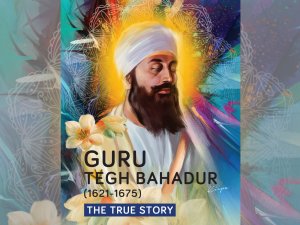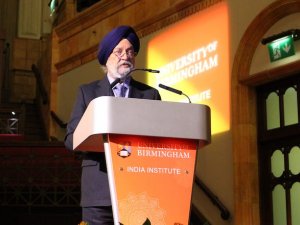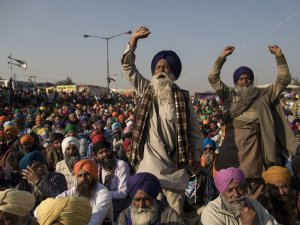Eleven years ago, a fanatic organisation called Al-Muhajiroun, announced public conversions of Sikh and Hindu girls. At Trafalgar Square, in London, UK. Young Sikhs, carrying banners announcing, "Recognise the Human Race as One", took up the challenge. They turned up for a peaceful demonstration and won the day.

With much pride in our Sikh youth, I wrote about the "Sikh Battle of Trafalgar". Two bullet points of my report were, "Full Marks to disciplined & well organised Young Khalsa"; and, "Responsible leadership was shown by young Sikhs epitomising the Sikh saint-warrior tradition".
Such is the relevance today, of the true Sikhi lesson learnt that day, that I am quoting at length from my news report of the event, before continuing the discussion about the need for responsible Sikh youth direction today.
"In 1805, at the Battle of Trafalgar, Nelson routed Napoleon's battle-fleet near the coast of South-West Spain at Cape Trafalgar. It was only befitting, that under Nelson's column towering Trafalgar Square, the forces of religious bigotry and disharmony were driven to some dark corner by the young Khalsa's message of peace in bright sunshine. And so, Sunday 25th July, 2004 marks an important progressive step for the UK Sikhs in clarifying their identity as "Sikh" and as "British" in that order. These students of Guru Tegh Bahadur announced to the whole world that they accepted fear from no one, nor were they there to frighten anyone. They were there to stand up to aggressive religious bigotry.
"The Sikhs arrived in Trafalgar Square mostly individually or in twos and threes from about 11.45 am. The police were there in numbers but were relaxed and friendly. Young Sikhs, mostly in blue dress with martial style dastaars (turbans), remained orderly and well behaved while "the Man In Blue" (Harjinder Singh Khalsa) and one or two others kept a watchful eye on all.
"There were probably a few Muhajirouns in the crowd keeping a low profile. Clearly, the news of Al-Muhajiroun's undignified retreat to Essex had not reached them in time!
"Sikhs were politely requested by the police to get behind a barrier to the right of the National Gallery (Charring Cross side) as the crowd grew and the extremist British National Party (BNP) also arrived and were held back on the other side. Except for two Jaikaras from the Sikh youth directed at BNP, things remained quiet.
"A youngish Gursikh mentor in blue asked all to sit down and then all recited the Paatth of Chaopai Sahib five times, followed by Ardaas and five resounding Jaikaras. All this went on as tourist cameras were flashing. There were TV cameras, banners announcing, "If you do not see God in all. You do not see God at all !", and a well-prepared leaflet headed, "Recognise the Human Race as One - Guru Gobind Singh." The Sikhs dispersed at about 2.30 pm without any incident, with an audible "Thank you gentlemen" from the police. Sanity had prevailed."
Eleven years ago, responsible but determined Sikh youth response to Al-Muhajiroun fanaticism won the day at Trafalgar Square. Despite some earlier apprehensions about the proposed action, responsible self-regulation on the day was praised by all.
The British Sikh Federation (BSF) praised the action of "all the good Sikhs who stood up publicly to these extremists. Such extremists had been spreading false articles against Sikhism in schools, colleges, and universities for several years with anonymous leaflets, as part of their systematic conversion process.....Now we know that this extremist group has been publicly identified with such views. It was publicity that put an end to it, not keeping quiet." (Kashmir Singh, BSF)
Indeed, "not keeping quiet", but the responsible approach was to first inform all concerned, including the authorities at the highest level, that the Muhajiroun press release was highly inflammatory and striking at the very roots of the Sikh as well as the British way of life.

Perhaps, today, there is an important lesson to be learnt from that incident: that the Sikh response to every situation has to be reasonable, informative and lawful. That has been the Sikh tradition even when opposing oppressive regimes. Some mentors need to bear in mind the responsibility they carry. Unlawful activities and a criminal record can ruin young lives.
Any action should be measured and self-disciplined with due regard to the impact and consequences. Lawful protests as a democratic right are much more effective than disorganised action which leads to bad language and even violence. Such behaviour distracts from the objectives of a just campaign and strengthens the opposition. No matter what the cause, the impact on the onlookers and Sangats is negative. Those opposing change or reforms win without doing anything! Media reporting is negative and damaging for the community's image.
Perhaps a digression is needed here to balance the impression gained so far that this is all about the behaviour, responsible or otherwise, of next generation Sikhs only. There is an increasing realisation that the root cause for young Sikh activism is the need for Gurdwara reforms. The reasons behind this activism range from raising awareness of Sikh issues and concerns e.g. about targeted grooming of vulnerable Sikh girls, to the "dwindling numbers of British born Sikhs engaging in Sangat, Seva and Simran".
It is significant that in recent years, the focus has been the Sikh "sanskaar" (rite) of Anand Karaj - Sikh religious marriage ceremony in Sangat before Sri Guru Granth Sahib. Amicable resolution of the issue of interfaith marriages is the aim; so that while Sikh Reht Maryada is observed, Sikhi remains inclusive.
Many feel that the objectives set out for the progress of UK Sikhs as a distinct community e.g. in the UK's Sikh Manifesto, are only possible if we set our own house in order. "Our house" is each Sikh family home linked to the Gurdwara. In Sikh tradition, both are regarded as "dharamsaal", places where righteous Sikh way of living is taught by example at home, and through Gur-Sangat in the Gurdwara.
"The Sikh community has struggled to effectively propagate the direction of Sri Guru Nanak Dev Ji in taking the message of truth to all communities. Accordingly we are seeing a dwindling numbers of British born Sikhs engaging in Sangat, Seva and Simran." (quote from a Miri Piri Foundation circular)
The "Sikh community" is represented by Gurdwaras, the miri-piri (temporal-spiritual) schools of Sikhi. Home and Gurdwara environments must be conducive to learning about Sikhi tradition. The importance of what goes on in our Gurdwaras cannot be isolated from the impression brought home by our children. Gurdwara parbandhaks should continually seek Sangat guidance regarding the needs of young Sikhs.
Recently I wrote about the origin of Gurmat camps in British Malaya. The ancient tradition of building Gurdwaras in Malaya, which catered for the needs of the next generations as a high priority, has continued. "Malaysian Sikhs have always considered Gurdwara as a place where Sikh youth could enjoy coming for fun activities and also learning about Sikhi. Most Gurdwaras have playgrounds, libraries, computer rooms, and extra programs outside the regular Sunday morning Sangat programmes." (quote from renowned Kirtania Dya Singh of Australia, born and brought up in Malaysia.)
So, it is not that those who guide Sikh youth are on the wrong track in their efforts to support progressive Gurdwara managements. For example, the Miri Piri Foundation circular clarifies that the objectives are Sikhi based, constructive, and, aimed at supporting Gurdwara managements in the area of guidance in relation to the sacred Sikh ceremony of Anand Karaj (Sikh religious marriage ceremony.)
The issue of Anand Karaj needs flexible but clear approach taking historical religio-cultural practices from the Guru-period through the 18 century Khalsa-led freedom struggle to the present day. For much of this period Panjab has been a "war zone". Many "Nanak Naam leva" communities have supported the freedom "sangharash" led by the Khalsa. Marriage as a religious ceremony is not so clearly defined in such an environment. (This is an area ring-fenced in the related Sikh Reht Maryada based guidance agreed by UK Gurdwaras through the Sikh Council UK forum, and will need amicable and inclusive discussion.)
Regarding most internal controversies, the spotlight is always on both sides. Education and reflection are needed on both sides. Reforms require patience and discussion about differing viewpoints about Sikh tradition.
We return to the main topic of responsible Sikh youth "direction". I have consciously avoided using the word "leaders" or "leadership". These are outdated concepts so far as Sikh tradition is concerned. These days, the futile and misguided search for "leaders" is readily met by plentiful supply of self styled "leaders". Leadership is a collective Panthic concept, which goes back to the revelation of the Khalsa Panth founded on Guru Nanak Sahib's egalitarian ideology. The discipline of identity, conduct and organisation was clarified by Guru Gobind Singh ji with a direct pointer to twin institution of Guru Granth and Guru Panth for future guidance.
External challenges to Sikh identity and the need for internal reforms can motivate and unite young Sikhs to positive activism. They raise awareness of Sikhi values while alerting young girls and boys to surrounding dangers in a society which seems to have lost its moral moorings, "the standards of good and evil, which govern an individual's behavior and choices". We see a ray of hope for the future in these Guru-guided mentors.
Regrettably, sometimes, we also see individuals in Sikhi bana (garments), leading what can only described as cults. Sikhs should not be "led" by or look for individual "leaders". The Sikh Reht Maryada (Sikh Code of Conduct and Conventions) gives us Sikhi advice and direction. It is divided into two parts. The first part defines a Sikh and guides the individual about Sikhi living. It is based on collective "khoj" (meditative research) of Gurbani in Sangat and as interpreted through the lives of Guru Sahibaan (1469 to 1708) and Panth Khalsa tradition exemplified by great Gursikh sant-sipahis, shaheeds (martyrs) and scholars through the centuries.
The essential message is there in the mainstream Sikh Reht Maryada. The first part can be equated to the spiritual or "piri" aspect of Sikhi. Gursikhs recite Gurbani and hold discourses in Sangat. They remain accountable to the Sangat. There is no question of any individual lead.
The second part of the Sikh Reht Maryada deals with "Facets of Corporate Sikh Life". Amongst other important aspects, this part deals with "Guru Panth" (the Order of the Khalsa) and the procedure for "collective resolutions". Once again, anyone looking for Sikh "leadership" in this part will be disappointed!
Collective decision making after contemplation of the Guru's Word is the Sikh way.
The institution of Sri Akal Takht Sahib is the focus of Sikh miri-piri (temporal-spiritual) living. It is a powerful symbol which directs Sikh miri-piri energy, strategy and activism. The guardians of Sri Akal Takht Sahib are accountable to the Khalsa Panth for directing Sikh affairs according the collective will of the Panth. Regrettably, that has not been the impression given by some incumbents of this high position in recent times. Therefore, the need is for reforms which can be achieved through dialogue initiated by Sangat-based organisations worldwide. This is a topic which needs further thought in the age of communications technology.
Breaking away and setting up parallel bodies cannot be the answer in an ever shrinking world.
The Guru Shabad in Sri Guru Granth Sahib, as given expression by Guru Khalsa Panth in Sikh Reht Maryada, is the only true Leader for the Sikhs. Young Sikhs should seek collective true Sikhi direction while exercising self-regulation, as shown eleven years ago at the Sikh battle of Trafalgar Square.
Gurmukh Singh
Principal UK Civil Servant ret'd
E-mail: [email protected]
Blog: http://sewauk.blogspot.co.uk/
Related Articles:
https://www.sikhiwiki.org/index.php/Al-Muhajiroun_%26_Religious_hatred
http://www.sikhnet.com/news/malaysian-background-gurmat-camps
http://www.sikhnet.com/news/camp-gian-2015
---------------------------------






